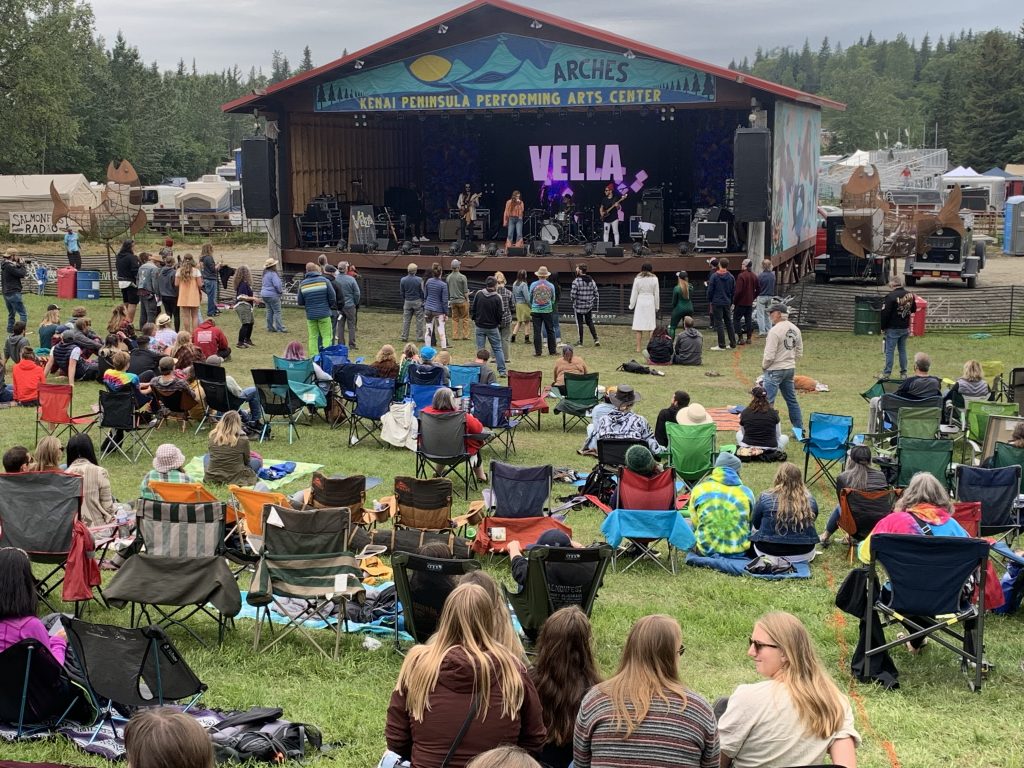
Salmonfest 2021, with over 60 bands ranging from Greensky Bluegrass, Sarah Jarosz, The High Hawks and Con Brio to Alaska’s Blackwater Railroad Company, entertained a sold-out crowd Aug. 6-8 at Ninilchik, under cool, mostly cloudy skies, in a much-expanded venue.
Plans for a main stage amphitheater offering those who chose to much more space to socially distance during the continuing pandemic came together within the final days before the event.
The dirt and brush-covered hillside emerged as an amphitheater with easy-to-navigate wide steps dug into the ground, supported by sturdy wood beams and railings, plus large wood picnic tables at several locations from the bottom to the top of the amphitheater, all in the family-friendly spirit of the festival.
Salmonfest also sold out rental spots for recreational vehicle campers and a number of tent camping spots, for the firs ttime offering festivalgoers camping spots adjacent to the fairgrounds. Renters had the option to reserve those spaces for future Salmonfests.
Jim Stearns, executive director of Salmonfest, said the festival would meet or exceed all Centers for Disease Control and Prevention guidelines in place due to the rapid spread of the delta variant of COVID-19, and also continue to strive to make Salmonfest a zero-waste event where all discarded materials were designed to become resources for others to use.
At the top of the amphitheater there were colorful hammocks under canopies, plus a refreshment stand offering a Boston seafood chowder with Alaska salmon and halibut, orange pecan brownies, peanut butter cookies and salmon bowls, all prepared by California-based gourmet cooks.
Rising from the lower level before the main stage to the top of the hill, festivalgoers relaxed in
their own lawn chairs, spread blankets on the grass, perched on benches behind fresh-cut log railings on the rise and otherwise spread out to socially distance as a cool breeze swept over the fairgrounds.
The other option, also wildly popular, was packing into the beer garden on the hillside above the main stage and joining other revelers in the mosh pit to dance.
Vendors touted everything from clothing and jewelry to pottery and an array of food choices, plus educational information of challenges from the Pebble and Donlin mines, both properties lying very close to critical salmon habitat. There were also activities for children, including face painting and games.
Salmonfest bills itself as a hub that supports all salmon-related causes. The Bristol Bay watershed, with the world’s largest run of wild sockeye salmon, has for years been a source of sustenance for thousands of people, as well as the abundant wildlife of the region. The sockeye salmon fishery, with over 40 million fish harvested just this year, has an estimated economic value of $1.5 billion in revenue and supports over 14,000 jobs.
The Since 2015, Salmonfest has donated over $150,000 to salmon and related initiatives. Those entities include Cook Inletkeeper, United Tribes of Bristol Bay public radio station KBCA, Musicians United to protect Bristol Bay and Alaskans Know Climate Change. The venue features a Salmon Causeway where festivalgoers can engage with representatives of conservation groups to learn more about what they can do to protect salmon habitat, particularly as climate change warms the planet. Several groups with a focus on Bristol Bay and other salmon rich areas were on hand this year, including Rylin Mcgee and Ryan Asytalos of SalmonState and Kyrstyn Kelly ad Gabe Canfield of Arctic Youth Ambassadors.
Several weeks ago, major processors in Bristol Bay collaborated with air carriers and others to deliver 25,000 pounds of king salmon caught in Bristol Bay to these communities, but much more salmon is needed to get these communities through the winter months.





